Note: This entry has been restored from old archives.
Prologue
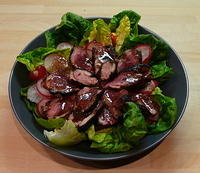
All along the backwater,
Through the rushes tall,
Ducks are a-dabbling,
Up tails all!Ducks’ tails, drakes’ tails,
Yellow feet a-quiver,
Yellow bills all out of sight
Busy in the river!
Wind In the Willows, Ratty’s “Ducks’ Ditty”… Actually, it brings Tom Bombadil into the fore of my mind, there’s a parallel I’ve not considered before; Tom and Ratty… Hmm, very literary, very picturesque, now let’s shoot a few of the damn ducks and get on with the show.
In actual fact the duck I’ve used in this recipe is neither wild or shot. Duck isn’t all that uncommon and in the UK you can find it in many supermarkets, even Tesco, and most butchers. Duck farming is smaller business than chickens, but is big enough that there are intensive duck rearers — poor ducks that never see the sky, let alone any kind of pond. If you’re going to buy duck please try and stick to “free range”, especially if also “organic” (nothing more unappetising than a silicon duck!).
For this recipe I found a nice looking pair of breast fillets at a local butcher. Large, fatty, luxurious breasts. On first sight of a duck breast fillet the you’re likely to note that it looks like there’s more fat than meat, and by volume there sometimes is! Don’t worry though, the breasts will transform into meaty nuggets once cooked and the layer of fat all but vanish (into a puddle in the pan). Compare the photo of the raw breasts to the one of the cooked one and you’ll get the idea.
Ingredients
Duck
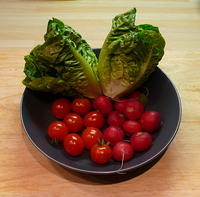
- 2 x 200g Duck Breast Fillets
- 10g Chestnut Honey[1] (or other honey)
- 10g good thick Balsamic Vinegar
- 1tsp fresh ground Black Pepper
- 2 cloves (6g) Garlic
- 100ml dry Red Wine
Dressing
- Reduced marinade (see below)
- 10g (~1 tbsp) Extra Virgin Olive Oil
- 10g (~1 tbsp) dry Red Wine
Salad
- 2 small (~100g each) lettuce, like “baby Cos”
- 100g Red Radishes
- 100g Cherry Tomatoes
Method
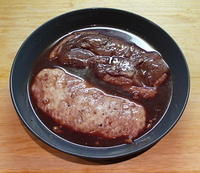
We start by marinating the breasts, at least an hour before cooking by preference. In my case about 6 hours, longer shouldn’t hurt (for example: start them marinating before you go to work in the morning so you can cook as soon as you get back).
Crush the garlic cloves into a bowl big enough to hold the duck. Add the chestnut honey[1], vinegar, wine and pepper and ensure the marinade is well blended. Slice into the fat-side of the fillets, about 6 slashes stopping short of slicing into the meat. Plonk the duck breasts into the marinade fat-side-up, cover, and into the fridge with the lot. Ideally you should flip the breasts every 1.5 to 2 hours, but this can be skipped.
Later…
Remove breast fillets from the marinade and pat dry with paper towels. Set marinade aside for later.
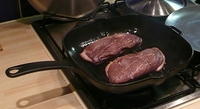
Pull out your heavy cast-iron pan, in my case a nice heavy square grill-pan, and very lightly oil the surface with a peanut or canola oil (for the high smoke-point). The oil is just to gauge the pan temperature, the duck will provide loads of fat of it’s own. Now put your pan on a high flame and heat until the oil just starts to smoke, at this point drop the temperature of the flame about 30%. In goes the duck! Quaaaaaacccck! Fat side-down for 5 minutes. Beware, it’ll hiss, spit, and smoke like anything. This is all normal, if it isn’t making a mess of your kitchen your pan isn’t hot enough.
While the duck gets it’s 5 minute sizzle you can separate the lettuce leaves. (If you need to wash your lettuce you should have done this earlier and washed the leaves so they can drain, soaking leaves make a mess of salad.) There’s no hurry though, the duck will need some resting and cooling time. Don’t rush yourself. Clean and slice the radishes, and quarter the baby tomatoes. The salad ingredient’s can be whatever you like. I think some avocado and blanched snow peas (mangetouts) would go very well with the duck.
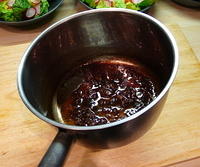
With 5 minutes passed flip the duck over and give two minutes on the meaty side. Done! Set the fillets aside on a plate somewhere out of the way.
Turn off the heat and pour the fat off the pan (to be discarded), be careful. Give the pan a couple of minutes to cool then dump in the marinade. Hiss! Give the pan a good scrape and then put the liquid back on the heat bubbling vigorously until it’s reduced to about 10% of the original volume (see photo right). In my case I poured and scraped the liquid out of the pan into a small saucepan. Reducing a sauce in a grill-pan is a path to much difficulty.
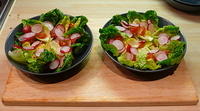
Strain the reduced liquid into a small pouring jug, helping it through a fine strainer with the back of a spoon, this gets rid of lumps of garlic and any errant chunks of crispy duck skin. Add the extra dash of red wine and the EVOO and mix it up a bit.
Now lay out the lettuce, tomatoes, and radish in a couple of shallow bowls (see left). At this time the duck should have had about 10 minutes to rest since coming out of the pan, if not then pour yourself a bit of wine to make up the time. Notice that the fat layer has reduced to a thin and crispy veneer, you’ll have poured away the majority of it’s volume from the pan. Now, you might want to remove the skin layer at this point, it’ll pull away easily, but note that it’s beautifully tasty! Get your sharpest knife and cut each fillet, across the grain, into slices no more than 5mm thick.
Arrange the duck slices on top of each salad in a double-circle, forming the titular “flower”. Give the dressing a good stir and drizzle over the salads. Add a couple of grinds of pepper.
Quack! With some wine!
Nutrition
Using non-mainstream meats is always a bit of a conundrum when it comes to calculating the nutritional profile of a meal. Duck is isn’t too bad on this front but free-range ducks can vary a fair bit from one critter to another and tend to be much leaner than intensively reared quackers, wild ducks even more so. With this in mind note that the calculated nutritional information will be even more “approximate” than usual (OK, there aren’t typically grades of approximation, in truth I should say “less accurate”).
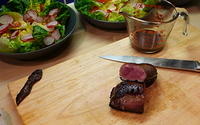
| Thing | Value |
|---|---|
| Energy | 432 kcal |
| Carbohydrate | 17.5g |
| Protein | 42.1g |
| Fat | 23.1g |
| Saturated | 5.4g |
| Dietry Fibre | 3.5g |
Epilogue
A very enjoyable meal, light and tasty. The duck was a little on the sinewey side but had excellent flavour. Next time I’ll try it with an Asian twist, some ginger, coriander, soy, and normal honey in the marinade. The salad would have worked better with some avocado, can’t go wrong with avo.
[1] Chestnut honey? I bought a jar of this a while back and the flavour is far too strong and bitter to use on porridge (our usual use for honey), you could even say the flavour is gamey. So this honey is only used for the occasional marinade where I think the flavour is going to work. In this case it worked really well I think! The recipe should be fine with normal honey though, but the flavour will certainly not be the same.